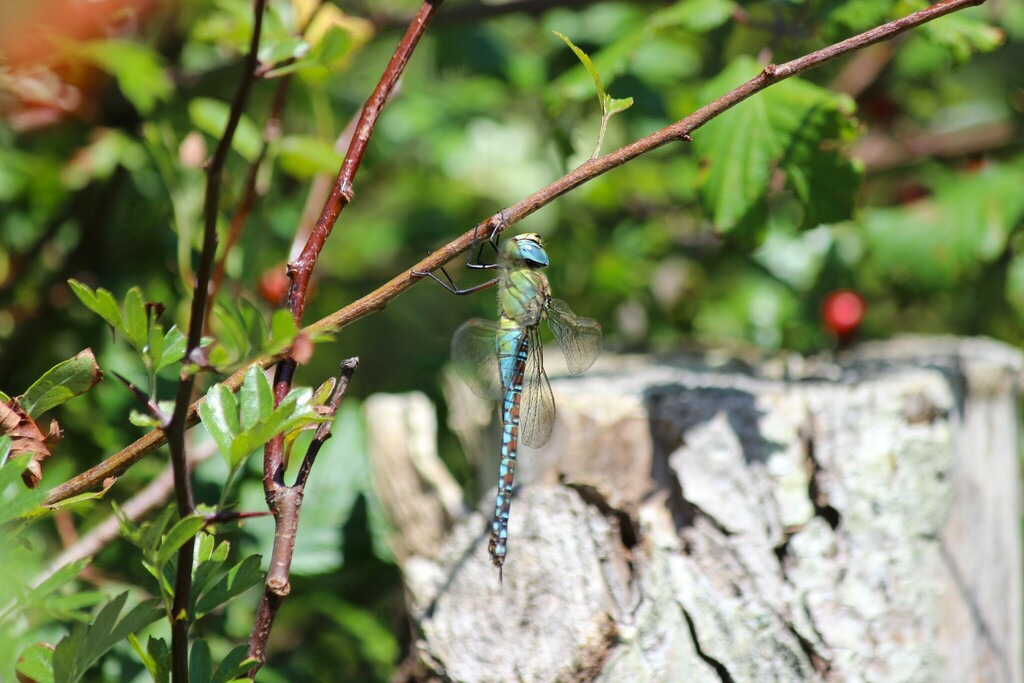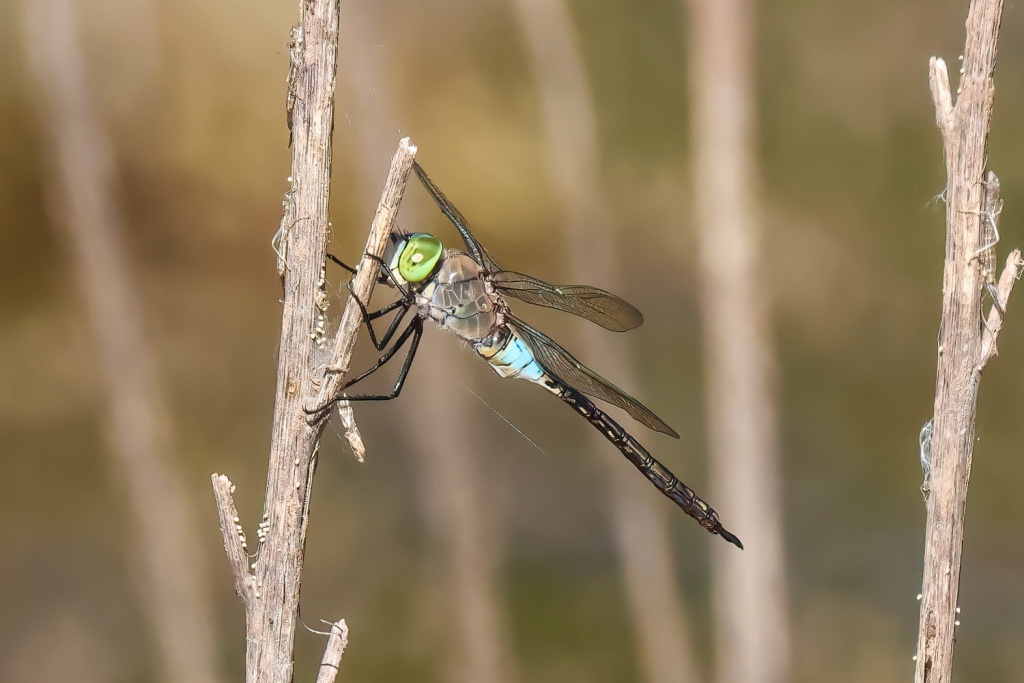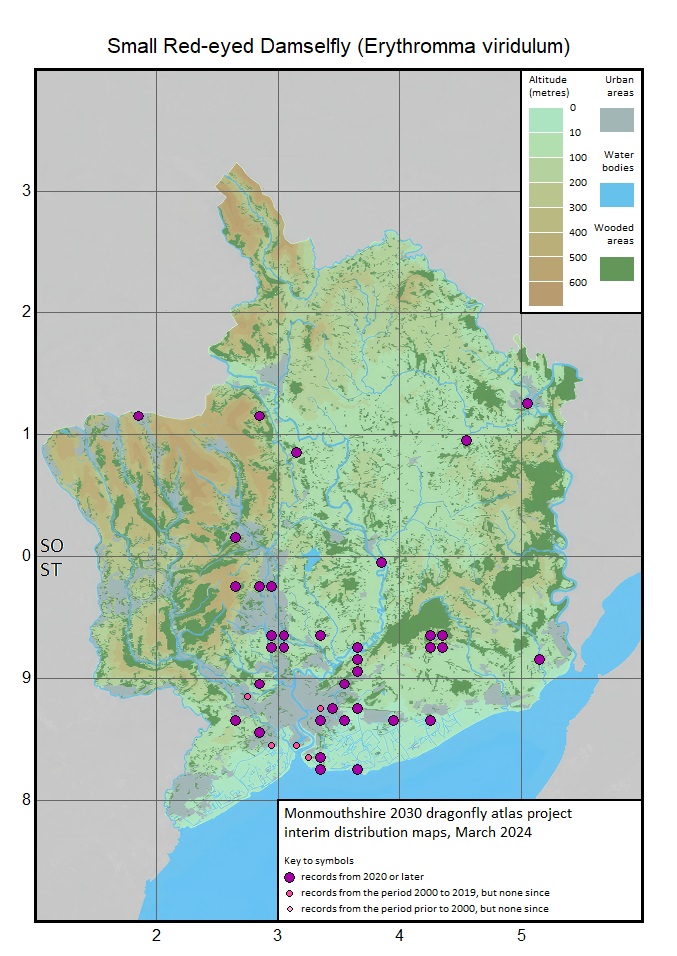Monmouthshire dragonfly recording update 7, March 2024
Welcome to the first of this year’s updates.
An update to the county atlas maps
The great work everyone put in last year recording dragonflies across the county meant that the atlas maps we put online just last year were already looking quite out of date. Generating new maps is quite a labour-intensive process, but it’s been worth it: new maps for all 33 species are now online at the British Dragonfly Society website, and they give a much better indication of where each species is found. Below are the before and after maps combining all records of all species, which shows just how much progress was made last year. We have six years left to go in our atlas project, so there’s plenty of time to make these maps even more complete.


Ideas for recording in 2024, and the recorder support scheme
If anyone would like some suggestions for targeted recording to do this coming season, here are some thoughts:
We still have a lot to discover about our riverine species, as the discoveries of Common Clubtail at Govilon and Skenfrith last year showed. From the middle of May onwards this species will be emerging on the Wye and the Monnow it would be good to know if it is still present in all the areas it has been recorded in historically. The Govilon sighting hints at the possibility of a population on the Usk too. There are many stretches of the Usk which have not been visited for dragonfly recording, so it could easily be there undetected. While surveying for this species, there’s the opportunity to fill in gaps on the map for Banded and Beautiful Demoiselles and White-legged Damselfly, and also Red-eyed Damselfly which has been recorded in localised areas on the Wye. There are lots of stretches of faster-flowing rivers in the county which haven’t been visited and where Beautiful Demoiselle and Golden-ringed Dragonfly are likely to occur.
On our upland, moorland sites, we have good populations of Black Darter, Common Hawker, Keeled Skimmer and Scarce Blue-tailed Damselfly, and a variety of other species but there are historical sites for these species which have not been visited recently, so searches away from the regularly-visited sites would be very worthwhile. Our small population of Brown Hawker is slowly expanding and searches for this species in the northwest could locate more new sites.
Our knowledge of the distribution of dragonflies on the Levels is improving, but there are still gaps where no-one has recorded dragonflies recently. Some of these areas may be genuinely dragonfly-free zones: the Levels are not uniformly species-rich as intensive agriculture has wiped out dragonfly populations in many places, but there are still areas that are under-explored, and mysteries to solve: is Ruddy Darter really absent from the western Levels, is Black-tailed Skimmer really missing from the east, and is the apparent decline in Large Red Damselfly real? There are many areas to be re-surveyed for Hairy Dragonfly, and the inconspicuous Variable Damselfly is very likely to occur at more sites than those we currently know about.
Finally, there are many areas of the county without any dragonfly records at all, or with only old records. If anyone would like a map of their part of the county showing rivers and ponds which we don’t have records from, please get in touch and I can send you one. Localised species such as Four-spotted Chaser and Emerald Damselfly are likely to be more common in the county than our current records indicate and visits to unexplored sites are a good way to find these species and more.
The British Dragonfly Society has made some funds available to enable a recorder support scheme to be set up. The funds will be used to help with travel costs for visits to under-recorded parts of the county. Anyone wishing to make use of the scheme will need to commit to visiting at least five unrecorded sites (but don’t worry, we have a long list of these to choose from, and they cover most parts of the county). If this is something which interests you, please get in touch.
More Southern Migrant Hawkers
After out first two Southern Migrant Hawkers, at Llandegfedd reservoir and Goldcliff nature reserve in 2019, it is perhaps surprising that none were seen in the subsequent three years. However, last summer saw our third and fourth records, both from the Gwent Levels. In August, Phil James found one at Goldcliff and Tom Chinnick found one at Uskmouth. The Goldcliff individual was particularly interesting as it was a female of the blue morph, which had not previously been recorded in Britain: one of Phil’s photos is included below. More details on these two dragonflies, and other rare visitors back as far as 1995, can be found at the Rarities section of the website.

Llandegfedd reservoir
Llandegfedd reservoir is the largest single still water body in the county, but we have comparatively few dragonfly records from the site. The site’s potential is indicated by the fact that it was where our first Southern Migrant Hawker was found by Gavin Vella in 2019. However, only nine species have been recorded there during our atlas period so far (Common Blue, Blue-tailed and Large Red Damselflies, Southern and Migrant Hawkers, Emperor and Golden-ringed Dragonflies, Black-tailed Skimmer and Common Darter), although four other species have been recorded there in the past (Azure and Emerald Damselflies, Banded Demoiselle and Broad-bodied Chaser). If anyone would like to visit the reservoir this year to survey it more thoroughly for dragonflies, I’d be keen to hear from you.
Breeding Lesser Emperors
In the previous update, I mentioned finding our first breeding records of Lesser Emperor at Wentwood reservoir with Lucy Arnold-Matthews and Ollie Jenkins-Boobyer. I’ve now written an article on this, which is illustrated with the excellent photo below taken the same day by Lee Gregory. This is a species which is expanding its range and is very likely to be found at further sites (previous records are from Ynys-y-Fro reservoirs and Lamby Lake, so your best chance of finding one is to search one of the county’s larger waterbodies … an incentive for anyone considering taking a look at Llandegfedd perhaps?)

Small Red-eyed Damselflies
The ongoing colonisation of the county by Small Red-eyed Damselfly took more leaps forward in 2023. The map below shows the sites where it has now occurred. It is now more common and widespread than Red-eyed Damselfly and is no longer confined to the south and east of the county, with new sites being found in the uplands around Blaenavon and Brynmawr, and at many new sites in between. This is not a species which needs particularly large or high-quality water bodies: it occurs at small farm ponds, and at Ponthir reservoir, for example, so it is very likely that there are many more sites waiting to be discovered.
One other piece of information which emerged this year is that Small Red-eyed Damselfly was recorded by David Gibbs at Newport Docks in 2015 as part of ecological survey work on some ponds there (the ponds no longer exist, as the land has been developed): previously, it had been thought that Tara Okon’s discovery of this species at Newport Wetlands in 2017 represented our first, so that now becomes our second record.

A Monmouthshire ponds and lakes inventory
In researching sites to visit for dragonfly recording as part of the county atlas project, it became apparent that there is no comprehensive list of ponds and lakes in Monmouthshire. So, as a parallel project, we’ve started to compile one. Ordnance Survey maps and Google Earth are good sources of information about the locations of ponds and lakes in the county, and this has yielded a list of over 800 possible candidates so far. Once a site has been visited, it is added to the inventory with some basic details (the location, the size, the date the waterbody was confirmed to still exist and so on). An initial inventory will be issued once it contains a good number of sites, hopefully at some point later this year, and then it will be periodically updated with further sites as more are visited.
Earliest records
One of the pieces of information included in the species accounts on the website is the first known record of each species from the county, but I thought it would also be of interest to list them together in one place. If you know of an earlier record of any of these species, please let me know.
| English name
|
Scientific name
|
Date
|
Location
|
Observer
|
|---|---|---|---|---|
| Hairy Dragonfly | Brachytron pratense | An unspecified date in 1929 | Marshfield, on the western Gwent Levels | F. Norton |
| Common Darter | Sympetrum striolatum | An unspecified date in 1949 | The Newport area | J. L. Jones |
| Ruddy Darter | Sympetrum sanguineum | An unspecified date in 1949 | The Newport area | J. L. Jones |
| Beautiful Demoiselle | Calopteryx virgo | An unspecified date in 1961 | Devauden, near Chepstow | P. C. Webb |
| Large Red Damselfly | Pyrrhosoma nymphula | An unspecified date in 1961 | Pen-ffordd-goch Pond (Keeper’s Pond) on the Blorenge | D. Griffiths |
| Common Hawker | Aeshna juncea | An unspecified date in 1961 | Pen-ffordd-goch Pond (Keeper’s Pond) on the Blorenge | D. Griffiths |
| Blue-tailed Damselfly | Ischnura elegans | An unspecified date in 1965 | Magor Marsh | K. Hallet |
| Common Blue Damselfly | Enallagma cyathigerum | An unspecified date in 1966 | Magor | P. C. Webb |
| Southern Hawker | Aeshna cyanea | An unspecified date in 1966 | Magor | P. C. Webb |
| Emerald Damselfly | Lestes sponsa | An unspecified date in 1967 | The Monmouthshire and Brecon canal near Sebastopol | Derek Bolton |
| Azure Damselfly | Coenagrion puella | 10 June 1968 | The Usk Valley | G. A. N. Horton |
| Banded Demoiselle | Calopteryx splendens | 9 July 1968 | The River Wye near Llandogo | W. A. Seaby |
| Broad-bodied Chaser | Libellula depressa | 27 June 1971 | Shirenewton, near Chepstow | P. C. Webb |
| Migrant Hawker | Aeshna mixta | An unspecified date in August 1973 | Whitson on the eastern Gwent Levels | P. M. Wade |
| Common Clubtail | Gomphus vulgatissimus | 18 May 1975 | The River Wye at Bigsweir | John Paul |
| White-legged Damselfly | Platycnemis pennipes | 24 June 1975 | The River Wye at Bigsweir | John Paul |
| Emperor Dragonfly | Anax imperator | 30 July 1978 | Whitson on the eastern Gwent Levels | D. A. Rodway |
| Golden-ringed Dragonfly | Cordulegaster boltonii | 14 May 1979 | Piercefield Park, in the Wye Valley near Chepstow | Ian Bolt |
| Variable Damselfly | Coenagrion pulchellum | 29 July 1981 | The Wentlooge level near St Brides | Colin and Ian McLean |
| Black Darter | Sympetrum danae | An unspecified date between 1975 and 1981 | The Blorenge | Bill Keen |
| Four-spotted Chaser | Libellula quadrimaculata | 25 May 1983 | Keeper’s pond on the Blorenge | Bill Keen |
| Scarce Blue-tailed Damselfly | Ischnura pumilio | 29 July 1983 | Cwm-Tysswg, south of Tredegar | A. D. Fox |
| Black-tailed Skimmer | Orthetrum cancellatum | 18 July 1984 | St Mellons | P. Jones |
| Yellow-winged Darter | Sympetrum flaveolum | 13 August 1995 | Magor Marsh | John Martin, Mike Powell and Clive Hurford |
| Brown Hawker | Aeshna grandis | 16 August 1995 | Waun-y-pound | Mike Powell |
| Keeled Skimmer | Orthetrum coerulescens | 25 July 1996 | The British, northwest of Pontypool | Steve Williams |
| Red-veined Darter | Sympetrum fonscolombii | 17 July 2000 | Goldcliff lagoons | Adam Rowlands |
| Lesser Emperor | Anax parthenope | 4 August 2006 | Lamby Lake | Andy Karran |
| Red-eyed Damselfly | Erythromma najas | 11 August 2007 | Coity Tips, Blaenavon | Steve Williams |
| Vagrant Emperor | Anax ephippiger | 25 October 2013 | Morden Road, Newport | Keith Cox |
| Small Red-eyed Damselfly | Erythromma viridulum | 15 July 2015 | Newport Docks | David Gibbs |
| Southern Migrant Hawker | Aeshna affinis | 13 August 2019 | Llandegfedd reservoir | Gavin Vella |
The sharp-eyed among you will notice one species missing from the table above: Small Red Damselfly (Ceriagrion tenellum). As part of an investigation into the status of this species UK-wide, all historical Monmouthshire records are being reviewed, and so far, we haven’t yet found any evidence that this species has been reliably recorded in the county. At present, it’s still included in our county list … but perhaps not for much longer.
Contributing your records
I’m happy to receive your records via any method which suits you: it’s better to receive a record than not to receive it. The iRecord system is my preferred method. If you’d like to use iRecord, please go to https://irecord.org.uk/ and create an account. I’m more than happy to show you how to use it over a video conference, or in person if you live somewhere within easy reach.
Steve Preddy, Monmouthshire County Dragonfly Recorder, British Dragonfly Society
